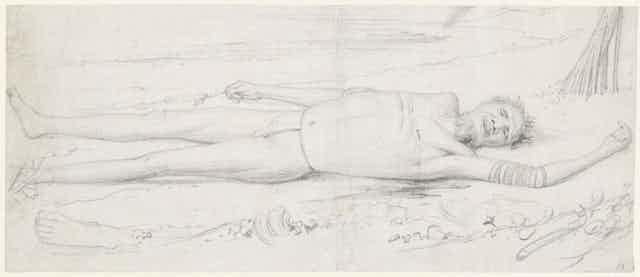The Investigator arrived off Cape Leeuwin, on the southwest tip of Western Australia, on 6 December 1801, captained by the 26-year-old Matthew Flinders. Feeling as though I know Flinders well through working on his personal writings over the past few years, I’ve become intrigued by his accounts of his dealings with the Indigenous people of Australia as the ship circumnavigated Australia. How might his habit of fair-mindedness have affected his behaviour?

Flinders left two accounts of his Investigator voyage. One was the official Voyage to Terra Australis (1814), written on his return to England seven years after the end of the voyage, during which time he was shipwrecked and then detained by the French on Mauritius. The other is a fair copy of his captain’s log, which has recently been published as Australia Circumnavigated.
Flinders and his crew first met some Noongar people on 14 December 1801. Before that, as Flinders reported in his Voyage to Terra Australis, they had not seen any of the “natives”, although “marks of the country being inhabited were found every where”. The people they met were “shy but not afraid”, Flinders wrote. Nine days later a group set off inland, and were met by a Noongar man:
He was very anxious that we should not go further; and acted with a good deal of resolution in first stopping one and then another of those who were foremost. He was not able to prevail; but we accommodated him so far as to make a circuit round the wood, where it seemed probable his family and female friends were placed.
The old man followed us, hallooing frequently to give information of our movements; … at length, growing tired of people who persevered in keeping a bad road in opposition to his recommendation of a better, which, indeed, had nothing objectionable in it but that it led directly contrary to where our object lay, he fell behind and left us.
Encounters like this, where no shots were fired, were often characterised as “friendly”, but, as academic Tiffany Shellam has pointed out, there were undercurrents of fear and insecurity, and Flinders, despite his rather sardonic tone here, actually had no idea what was happening.

If there were undercurrents of violence and fear even in this “friendly” encounter, they surfaced with tragic results a year later when the Investigator reached Blue Mud Bay, the land of the Djalkiripuyngu people, part of the Yolngu-speaking territory in the Northern Territory.
The Master’s Mate of the Investigator was speared while collecting wood with some of his crew mates, and in retaliation at least one Djalkiripuyngu man was killed.
Flinders was not in the landing party, and was angry with the Master for initiating a revenge attack, “forgetting the orders I had given him”. Though he didn’t understand the motives behind the spearing, Flinders knew the danger posed by his men’s aggressive behaviour.
However, he recorded no punishments for those involved, and, to add insult to injury, sent a boat ashore the next day to collect the dead body for his scientists to examine. He doesn’t mention returning the body later. Such disrespect seems like a flagrant breach of the behaviour Flinders expected of himself and those under his command. Did he think that the claims of science overrode respect for the dead?
The evidence of Flinders’ feelings of empathy with the Aboriginal people he encountered is, I concede, slight. In Australia Circumnavigated, he expressed mild though not insurmountable regret at the death of the man at Morgan’s Island.
He refers to Woga, a young man held hostage on the ship for a day in February 1803 as “the poor Indian”. So far this is more sympathy than empathy. The most direct expression of empathy is in Voyage to Terra Australis:
What … would be the conduct of any people, ourselves for instance, were we living in a state of nature, frequently at war with our neighbours, and ignorant of the existence of any other nation?
This, written ten years after the voyage, after many trials and disappointments, and after much time for contemplation during his detention by the French, might be a unique instance of Flinders’ imaginative identification with the Aboriginal people.

As for the way any feelings of empathy might have been expressed in his actions during the Investigator voyage, I just don’t think they entered the equation. As a matter of pure humanity he would prefer not to cause pain to other human beings, but in all his actions as captain of the Investigator his duty was to explore and map the Australian coast, to keep his ship’s company safe, and to smooth the way for future explorations.
In most cases, he deemed that humane treatment and forbearance was the best way to do this, but if a show of force, even firing with intent to wound, was needed “to convince them that we were not to be insulted”, he would not shrink from doing his duty as he saw it.
The limits of empathy are defined by duty – and Flinders’ duty was in the final analysis dictated by policy rather than feelings or morality.
Gillian Dooley will present a paper based on this research at the InASA Conference in Fremantle this week. With Danielle Clode, she is co-editing a book titled The First Wave: Exploring Early Coastal Contact History in Australia.

